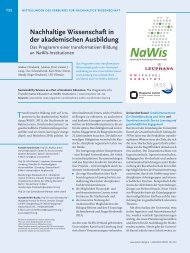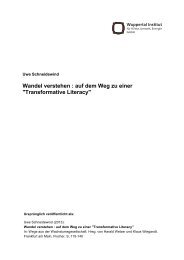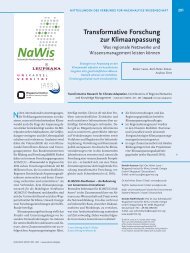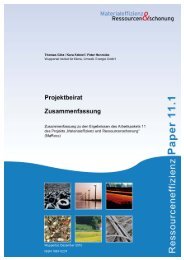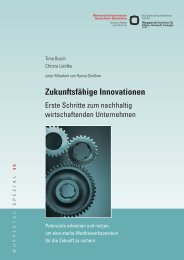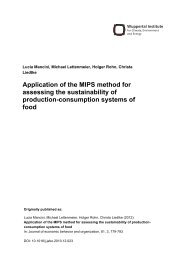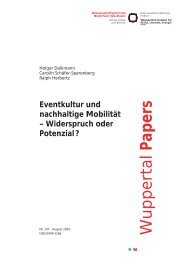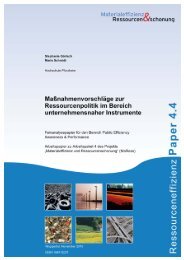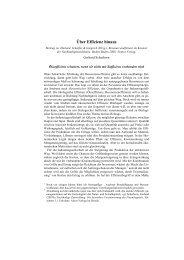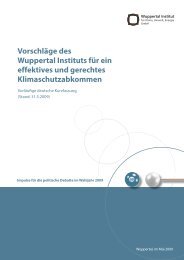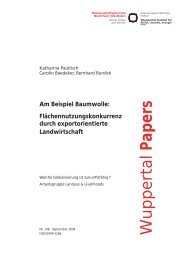Resource Efficiency Atlas - Publication Server of the Wuppertal ...
Resource Efficiency Atlas - Publication Server of the Wuppertal ...
Resource Efficiency Atlas - Publication Server of the Wuppertal ...
Create successful ePaper yourself
Turn your PDF publications into a flip-book with our unique Google optimized e-Paper software.
72<br />
Chapter 4: Strategic starting-points for more resource efficiency<br />
The UK’s ’’National Industrial Symbiosis Programme’’ is a<br />
good example <strong>of</strong> a successful communication strategy (p.<br />
64). It is based on <strong>the</strong> circular economy concept and a network<br />
<strong>of</strong> businesses. With <strong>the</strong> assistance <strong>of</strong> this programme<br />
a large number <strong>of</strong> companies could optimize <strong>the</strong>ir production<br />
processes leading to environmental and economic<br />
benefits. Ano<strong>the</strong>r successful example is <strong>the</strong> initiative called<br />
“gravel for generations” aiming at a resource efficient construction<br />
sector (p. 66). The initiative provides information<br />
about <strong>the</strong> possibilities <strong>of</strong> economic recycling and repro-<br />
cessing <strong>of</strong> building demolition. The efficiency potential is<br />
backed up by scientific studies and projects.<br />
Promoting market entrance<br />
The interviewed experts argue that all identified technol-<br />
ogy fields bear remarkable resource efficiency potentials.<br />
However, <strong>the</strong>y are still only ‘tools’ depending on surround-<br />
ing conditions (see chapter 2.2). Promising, resource effi-<br />
cient technology and products, which require high investments,<br />
have to be promoted through pilot projects within<br />
<strong>the</strong> market launch phase. Attractive funding conditions<br />
and programmes should be used to support companies<br />
not yet adjusted to innovation programmes.<br />
In research and development, sustainability and resource<br />
efficiency need to be integrated. Existing funding<br />
opportunities need to be promoted. As stated in chapter<br />
1.2 many support programmes are already existent in Ger-<br />
many (e.g. www.fona.de). Even with regard to resource<br />
efficiency many federal promotion activities are in place,<br />
such as promotion programmes for environmental technologies<br />
<strong>of</strong> <strong>the</strong> German Ministries BMU, BMWI and BMBF,<br />
<strong>the</strong> programmes VerMat and NeMat as well as <strong>the</strong> German<br />
Material <strong>Efficiency</strong> Prize <strong>of</strong> <strong>the</strong> BMWI, <strong>the</strong> development <strong>of</strong><br />
institutional structures at <strong>the</strong> federal state level such as <strong>the</strong><br />
<strong>Efficiency</strong> Agency <strong>of</strong> NRW and industry initiatives.<br />
Ressourceneffizienzatlas<br />
<strong>Resource</strong> <strong>Efficiency</strong> <strong>Atlas</strong><br />
Development <strong>of</strong> international education and<br />
cooperation networks<br />
To accelerate <strong>the</strong> development and diffusion <strong>of</strong> resource ef-<br />
ficient technologies and products <strong>the</strong> fur<strong>the</strong>r expansion <strong>of</strong><br />
education and cooperation networks (such as <strong>the</strong> network<br />
resource efficiency <strong>of</strong> <strong>the</strong> BMU, network <strong>of</strong> cleaner production<br />
center <strong>of</strong> UNIDO) is desirable. Fur<strong>the</strong>rmore, <strong>the</strong> network<br />
<strong>of</strong> universities integrating <strong>the</strong> paradigm <strong>of</strong> resource<br />
efficiency in teaching and research should be internationally<br />
expanded. A very limited amount <strong>of</strong> university departments<br />
<strong>of</strong>fer programmes (e.g. lectures, exercises, project<br />
work) related to resource efficiency. The topic <strong>of</strong> resource<br />
efficiency in research and teaching should be promoted in<br />
cooperation with <strong>the</strong> leading technical universities in Germany<br />
(TU9) and o<strong>the</strong>r design and technical universities <strong>of</strong><br />
applied science as well as international universities. A significant<br />
expansion <strong>of</strong> teaching programmes is recommended<br />
which needs to be integrated into <strong>the</strong> existing curricula.<br />
Activities towards <strong>the</strong> establishment <strong>of</strong> a ’’virtual resource<br />
university’’ (with focus on implementation processes) could<br />
boost <strong>the</strong> widespread integration <strong>of</strong> resource efficiency in<br />
university research and teaching (Krist<strong>of</strong> / Liedtke 2010).<br />
The virtual resource university can be realised as online<br />
platform to connect national and international university<br />
chairs dealing with resource efficiency.



